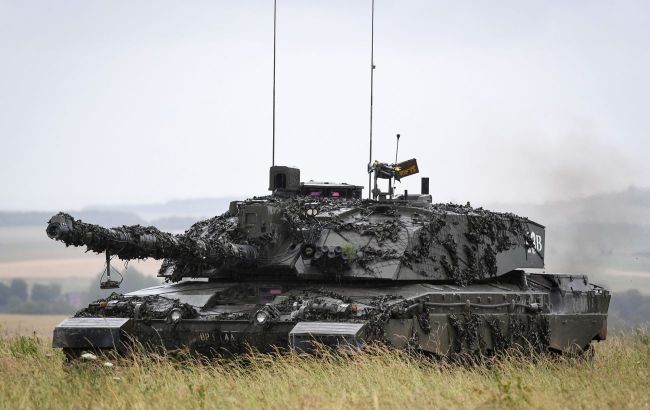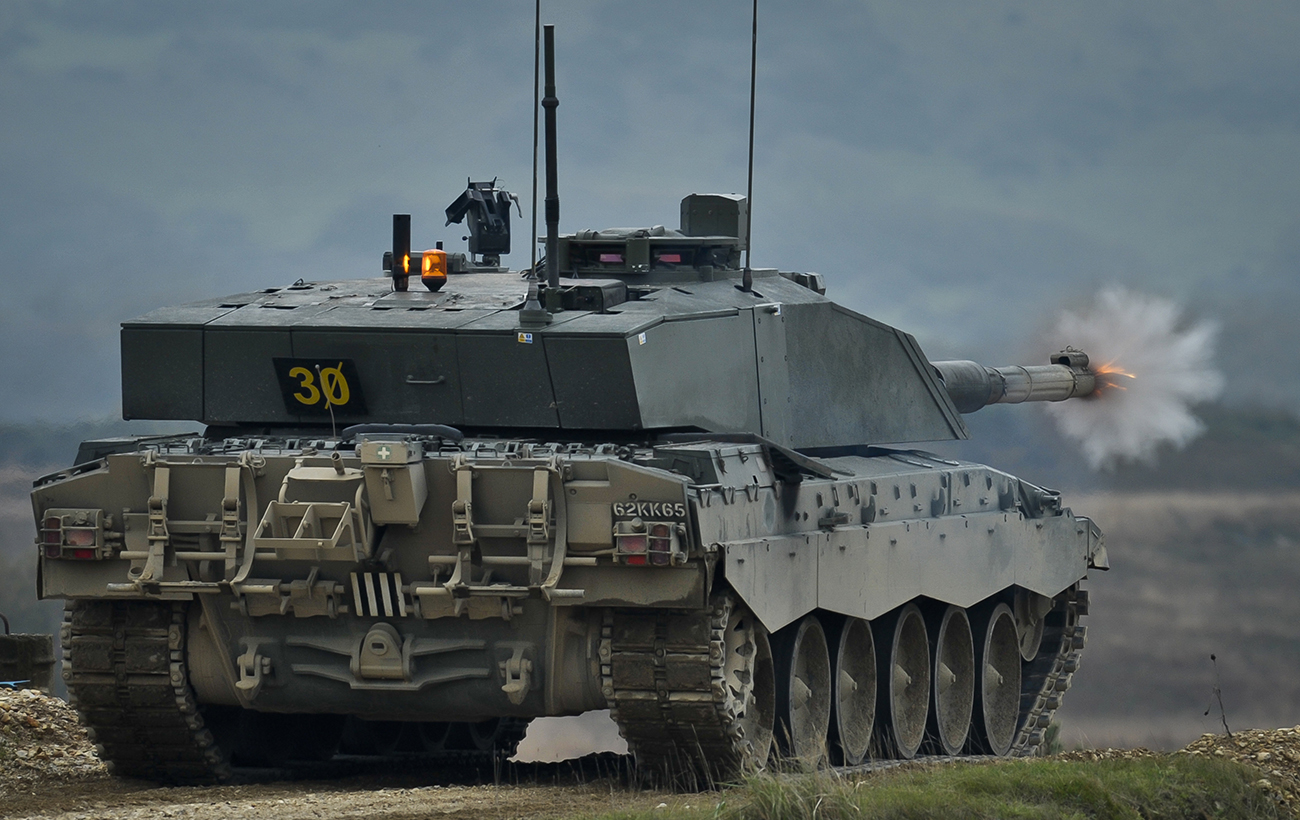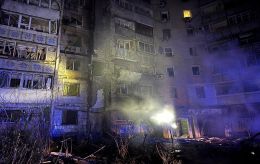First Challenger 2 tank destroyed in battle: Unique features and capabilities unveiled
 Challenger 2 (Photo: Getty Images)
Challenger 2 (Photo: Getty Images)
It appears that Ukrainian forces have lost one of the Challenger 2 tanks provided by the United Kingdom. This marks the first time such a tank has been destroyed in combat.
For all the known details and information about the Challenger 2, you can read in RBC-Ukraine material.
What happened and where
Recently, a video surfaced online showing a burning Challenger 2 tank. These tanks are part of the arsenal of the 82nd Separate Airborne Assault Brigade of the Armed Forces of Ukraine, which is currently advancing in the Zaporizhzhia region. This includes the area near the village of Robotyne, where the first line of defense of Russian occupiers was breached.
There is little doubt that the Challenger 2 in the video has suffered significant damage. At the beginning of the footage, you can see the distinct barrel surrounded by thick smoke, spare fuel tanks, and an armored thermal imaging box, which is installed on these tanks.
Destroyed Ukrainian Challenger 2 outside of Robotyne, most likely from the 82nd Air Assault Brigade. pic.twitter.com/KInjnmfs4F
— OSINTtechnical (@Osinttechnical) September 5, 2023
According to The Guardian, citing sources, the tank was detonated on a mine, which triggered the explosion of the rear fuel compartment. The crew safely evacuated. Later, a strike drone named Lancet hit the Challenger 2.
In the published footage, there are no signs of an internal explosion, and the combat vehicle is burning, although not completely destroyed. However, according to a military-political expert from the "Information Resistance" group, Oleksandr Kovalenko, this tank is considered irreparably lost.
"It cannot be restored, and it can be considered destroyed. When a tank hits a mine, after the explosion, it loses its mobility and becomes an easy target for any means of attack. You can have the best armor in the world, like in the Challenger 2, but if you're not mobile, you can still be defeated," he stated in a comment to RBC-Ukraine.
First destroyed in battle
The production of Challenger 2 tanks began in 1994, and in 1995, they were introduced into the British army's arsenal. It is considered that prior to the Russian-Ukrainian war, no Challenger 2 tank had been destroyed in combat.
During the 2003 mission in Iraq, there was an incident where one tank mistakenly targeted another. Two crew members were killed in this friendly fire incident. Additionally, in 2007, the frontal armor of a Challenger 2 was penetrated by an anti-tank rocket, resulting in injuries to three crew members, but the tank itself was not destroyed.
This "record" is partially due to the relatively small number of Challenger 2 tanks produced and their infrequent deployment.

Photo: Prior to the Russian-Ukrainian war, only one Challenger 2 tank was completely destroyed, and that was due to friendly fire (Getty Images).
Today, the new British Defense Secretary, Grant Shapps, confirmed to Sky News the destruction of the tank.
"It may be the first loss, as far as we’re aware. We gifted 14 of these Challenger 2 tanks to Ukraine. We accept that in the war zone, there can be material losses " he said.
According to him, the tank was hit by artillery fire, and when the crew tried to extinguish the flames, it was hit again. He also added that everyone survived, but he mentioned the number as 6 people. However, the standard crew consists of a commander, a driver-mechanic, a gunner, and a loader.
"I don't know if there were two more people there, and if there were, who they were. The main thing is that everyone survived. We don't react very well to destroyed or damaged equipment. The same happened with the Leopard 2: we are shocked, while Russian propaganda celebrates. Any equipment can be destroyed; there is no invulnerable 'wunderwaffe' (miracle weapon -Ed,). But the difference is in the chances for the crew to remain intact when a tank is hit," explained Oleksandr Kovalenko.
The British minister has already stated that there are no plans to replace the tank.
Key points about Challenger 2
The tank is armed with a 120mm rifled gun, stabilized in two planes. It has a fairly high rate of fire, with the crew capable of hitting up to 7 targets per minute. The combat load includes armor-piercing sub-caliber and high-explosive shells.
Despite its similarity to the American Abrams and the German Leopard 2, the tank uses non-standard NATO separable charge ammunition.
Other characteristics:
- Ammunition capacity: 52 rounds
- Effective firing range: Up to 8 km
- Machine guns: 1×7.62mm L94A1, 1×7.62mm L37A2
- Road speed: 56 km/h, Off-road speed: 40 km/h
- Road range: 400 km, Off-road range: 250 km
- Weight: From 65 to 75 tons
- Armor: Composite, including ceramic and metal elements with tungsten or depleted uranium. This armor is highly effective against both APFSDS (Armor-Piercing Fin-Stabilized Discarding Sabot) and HEAT (High-Explosive Anti-Tank) rounds.
The armor is one of the main features of the Challenger 2. It is known to consist of special packages with ceramic and metallic elements made of tungsten or depleted uranium. This type of protection is highly effective against both sub-caliber projectiles and cumulative munitions.
Versions with a weight of up to 75 tons are equipped with additional armor modules for enhanced protection. However, the heavier reinforced variants have lower maneuverability.
Better than Soviet-era tanks
Recently, a report surfaced on social media from Ukrainian tank crews who have operated Challenger 2, where one of the crew members shared their impressions of the tank and its advantages.
In particular, the driver-mechanic emphasized its long-range accuracy and effectiveness. According to his opinion, Challenger 2's primary target should be enemy vehicles.
"This tank is like a sniper rifle among all tanks," he emphasized.
He also mentioned that he had had experience operating T-64, T-72, and T-80 tanks, but Challenger 2 was significantly better.
"I fought on the T-80 once - only one attempt. Once it hits you, that's it, your chances are slim, the ammunition detonates immediately, and you go up in flames. On this tank, the ammunition is positioned in a way that it can withstand several hits. And even if it gets penetrated, there's no guarantee it will hit the ammunition and cause it to detonate," the soldier added.
As of now, the Ukrainian side has not showcased the combat performance of Challenger 2. However, the video from the Zaporizhzhia region once again demonstrates the high level of survivability. It's worth noting that the British vehicle detonated on a mine, not from a direct hit.
According to Oleksandr Kovalenko, it's unlikely that the "heavy" tank would react the same way in a similar situation.
"Sometimes hitting an anti-tank mine can have dire consequences for the crew, for example, on a T-72. It all depends on where the mine detonates and whether it triggers the detonation of the ammunition. Interestingly, one of the best anti-mine protections was in the old T-62, even though all other armor elements were significantly weaker," the expert explained.
Losses are inevitable
As of now, Ukraine's allies have transferred around a hundred Western-model tanks to Ukraine. In three months of counteroffensive operations, one Challenger 2 and up to six Leopard 2 tanks have been lost.
"One could say that the losses are minimal when compared to the number of modern Russian tanks destroyed during this time. For example, the modernized 2022 versions of T-90M Proryv, T-72B3, and T-80 BVM tanks have been burnt in dozens, and there's no comparison with the number of destroyed Western equipment," the expert emphasized.
However, it's important to understand that during intense combat, losses will only increase.
"We are in a full-scale war of this level, in which neither Challenger 2, nor Leopard 2, nor American Abrams have ever participated. The legendary Abrams hasn't even arrived yet, but when it does, unfortunately, we will also see how it burns. The main thing is for them to preserve their crews, as Challenger and Leopard do in Ukraine," he concluded.
It's worth noting that by mid-September, 10 Abrams tanks are expected out of the promised 31. Denmark and the Netherlands have ordered another 14 Leopard 2 tanks, and discussions are ongoing for the transfer of over a hundred Leopard 1 tanks.

